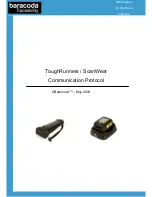
4
Common Blocks
The 368 has 2 common blocks for both the RTU inputs and the relay outputs. Each
common block has a terminal starting with
Com (Eg. Com Sen or Com 1-2 ). Each
common block can be used for either two One Stage zones or one Two Stage zone.
One Stage Common Blocks
If an RTU is connected to the lowest number in the common block, a One Stage common
block is created.
Example An RTU connected between the terminals
Com Sen — RTU 1 is used to control
the output relay
1, and an RTU connected between the terminals Com Sen —
RTU 2 is used to control the output relay 2.
Note If only one RTU is used, it must be placed on the lower number in the common
block. In the above example this would be
Com Sen — RTU 1 controlling output
relay
Com 1-2 — 1.
PID Zoning Logic
The 368 operation is based on a 15 minute cycle. During each cycle,
the control turns on the zone relay for a specific on time. This zone
on time is calculated based on the PID response of the zone during
the previous 15 minute period. If the zone needs more heat, the on
time is increased and if the zone needs less heat, the on time is
reduced. In order to prevent short cycling, the 368 ensures that the
zone relays remain on or off for at least 3 minutes.
Two Stage Common Blocks
When a single RTU is connected to the highest terminal number in the common block,
a Two Stage common block is created. The single RTU therefore controls two output
relays: a
Lo stage relay and a Hi stage relay.
Example An RTU connected between the terminals
Com Sen — RTU 2 is used to
control the output relays
1 and 2. Relay 1 is the Lo stage output relay and relay
2 is the Hi stage output relay.
PID Zoning logic
The temperature within each Two Stage zone is controlled by
varying the on time of the output relays over a 15 minute period.
During light loads, the 368 cycles the
Lo stage relay on and off. As
the load increases, the
Lo stage relay on time increases until it
reaches a maximum of 15 minutes. The
Hi stage relay is then turned
on and its on time is increased as the load increases. When the
heating load decreases again, the on time of the
Hi stage relay is
reduced until the
Hi stage relay is turned off completely. The control
then starts to reduce the on time of the
Lo stage relay.
Zone Control Load Staggering and Synchronization
The 368 staggers the operation of the zones in order to achieve a steady load on the boiler while minimizing boiler running time and
preventing boiler short cycling. Multiple Zone Controls can be connected together to increase the number of zones. Each of the Zone
Controls synchronizes its zone operating cycles based on the
Zo In input from the other Zone Controls. This results in a more stable
system flow rate and improved boiler operation.
Zone Control Operation with a tekmar House Control
The 368 can communicate with a tekmar House Control in order to
provide indoor temperature feedback, turn on the system pump and
operate the boiler. When multiple Zone Controls are used, each Zone
Control sequentially passes the information to the tekmar House
Control. This ensures that the heat requirements of all zones are
satisfied. When the 368 is requesting heat from the House Control, the
Heat Required light is turned on.
Fast Acting Zone Valves or Zone Pumps
If the
Thermal Motor DIP switch is set to Off, the 368 assumes that fast acting (electric
motor) zone valves or zone pumps are connected to the zone relays. The
Heat Required
light is therefore turned on as soon as the first zone relay is turned on. One minute before
the last zone relay is turned off, the 368 purges the boiler by signaling to the House Control
to turn off the boiler and keep the system pump operating.
LR 58233
E150539
LR 58233
E150539
tekmar Zone Control
tekmar Zone Control
15 minute Cycle
Lo Stage
Lo Stage
Hi Stage
Hi Stage
Lo Stage
Hi Stage
Lo Stage
Off
Off
Off
On
On
On
On
On
H
C
R
Lo
Stage
Hi
Stage
M
M
Com
1-2
15
1
16
2
17
Com
Sen
5
6
RTU
1
RTU
2
7
Relay On Time
Relay On Time
Relay On Time
Less Heat
More Heat
15 minute Cycle
H
C
R
Zone 1
Zone 2
H
M
M
Com
1-2
15
1
16
2
17
Com
Sen
5
6
RTU
1
RTU
2
7
Fast acting
zone valve
or zone pump
Off
Thermal Motor






























